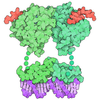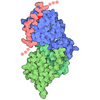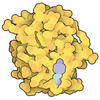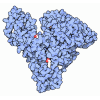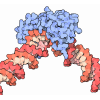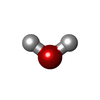Entry Database : PDB / ID : 9s71Title Crystal structure of RXR alpha LBD bound to a partial agonist 35 and a coactivator fragment SRC1 Nuclear receptor coactivator 1 Retinoic acid receptor RXR-alpha Keywords / / / / / / Function / homology Function Domain/homology Component
/ / / / / / / / / / / / / / / / / / / / / / / / / / / / / / / / / / / / / / / / / / / / / / / / / / / / / / / / / / / / / / / / / / / / / / / / / / / / / / / / / / / / / / / / / / / / / / / / / / / / / / / / / / / / / / / / / / / / / / / / / / / / / / / / / / / / / / / / / / / / / / / / / / / / / / / / / / / / / Biological species Homo sapiens (human)Method / / / Resolution : 2 Å Authors Morozov, V. / Merk, D. / Lewandowski, M. Funding support 1items Organization Grant number Country Not funded
Journal : To Be Published Title : Crystal structure of RXR alpha LBD bound to a partial agonist 35 and a coactivator fragment SRC1Authors : Morozov, V. / Merk, D. / Lewandowski, M. History Deposition Aug 1, 2025 Deposition site / Processing site Revision 1.0 Oct 29, 2025 Provider / Type
 Yorodumi
Yorodumi Open data
Open data Basic information
Basic information Components
Components Keywords
Keywords Function and homology information
Function and homology information Homo sapiens (human)
Homo sapiens (human) X-RAY DIFFRACTION /
X-RAY DIFFRACTION /  SYNCHROTRON /
SYNCHROTRON /  MOLECULAR REPLACEMENT / Resolution: 2 Å
MOLECULAR REPLACEMENT / Resolution: 2 Å  Authors
Authors Citation
Citation Journal: To Be Published
Journal: To Be Published Structure visualization
Structure visualization Molmil
Molmil Jmol/JSmol
Jmol/JSmol Downloads & links
Downloads & links Download
Download 9s71.cif.gz
9s71.cif.gz PDBx/mmCIF format
PDBx/mmCIF format pdb9s71.ent.gz
pdb9s71.ent.gz PDB format
PDB format 9s71.json.gz
9s71.json.gz PDBx/mmJSON format
PDBx/mmJSON format Other downloads
Other downloads 9s71_validation.pdf.gz
9s71_validation.pdf.gz wwPDB validaton report
wwPDB validaton report 9s71_full_validation.pdf.gz
9s71_full_validation.pdf.gz 9s71_validation.xml.gz
9s71_validation.xml.gz 9s71_validation.cif.gz
9s71_validation.cif.gz https://data.pdbj.org/pub/pdb/validation_reports/s7/9s71
https://data.pdbj.org/pub/pdb/validation_reports/s7/9s71 ftp://data.pdbj.org/pub/pdb/validation_reports/s7/9s71
ftp://data.pdbj.org/pub/pdb/validation_reports/s7/9s71 F&H Search
F&H Search Links
Links Assembly
Assembly
 Components
Components Homo sapiens (human) / Gene: RXRA, NR2B1 / Production host:
Homo sapiens (human) / Gene: RXRA, NR2B1 / Production host: 
 Homo sapiens (human) / References: UniProt: Q15788, histone acetyltransferase
Homo sapiens (human) / References: UniProt: Q15788, histone acetyltransferase X-RAY DIFFRACTION / Number of used crystals: 1
X-RAY DIFFRACTION / Number of used crystals: 1  Sample preparation
Sample preparation SYNCHROTRON / Site:
SYNCHROTRON / Site:  ESRF
ESRF  / Beamline: ID23-2 / Wavelength: 0.8731 Å
/ Beamline: ID23-2 / Wavelength: 0.8731 Å Processing
Processing MOLECULAR REPLACEMENT / Resolution: 2→35.25 Å / SU ML: 0.2129 / Cross valid method: FREE R-VALUE / σ(F): 1.36 / Phase error: 21.5942
MOLECULAR REPLACEMENT / Resolution: 2→35.25 Å / SU ML: 0.2129 / Cross valid method: FREE R-VALUE / σ(F): 1.36 / Phase error: 21.5942  Movie
Movie Controller
Controller



 PDBj
PDBj
